Добрый день.
Перед тем как подключить к компьютеру по USB устройство: СAN-Hacker, СAN фильтр или другое устройство на контроллере STM, необходимо установить драйвер виртуального СОМ порта.
Драйвера для устройства могут быть установлены для операционных систем Windows 2000, XP, Server 2003, Vista, Windows 7, Server 2008, Windows10 для 32-х и 64-х битных систем. Можно использовать версию, поставляемую в комплекте или скачать с сайта STMicroelectronics. Ссылка чтобы загрузить драйвера с сайта STMicroelectronics:
www.st.com/en/development-tools/stsw-stm32102.html
Рекомендуется использовать версию драйверов 1.4.0 и выше, для работы в режиме виртуально СОМ порта. Порядок действий для установки драйверов (диалоговые окна могут отличаться в зависимости от версии Windows):
• Загрузить архив c драйверами и распаковать его во временную папку на жестком диске;
• Рекомендуется отключить ПК от сети Интернет для предотвращения автоматического поиска и загрузки драйверов (обязательно для Windows Vista);
• Запустить файл для инсталляции драйверов VCP_V1.4.0_Setup.exe (версия 1.4.0);
Для Windows старше чем, Windows XP:
• Для Windows старше чем, Windows XP драйвера не устанавливаются, а копируются в папку:
C:\Program Files\STMicroelectronics\Software\Virtual comport driver\
• В зависимости от операционной системы в папке Virtual comport driver нужно выбрать папку Win7 или Win8 для входа. Для Windows старше Windows 8, нужно выбрать папку Win8.
• В зависимости от разрядности операционный системы необходимо запустить файл для установки драйверов: dpinst_x86.exe – для 32-х битных систем или dpinst_amd64.exe – для 64-х битных систем;
• Система выполнит копирование и установку файлов драйвера на Ваш ПК;
• В процессе установки ответ на предупреждение системы об отсутствии цифровой подписи драйвера, нажмите кнопку «Все равно продолжить»;
• Подключить устройства к ПК, используя интерфейсный кабель USB;
• Система автоматически найдет новое оборудование и установит его;
• После установки в диспетчере устройств его можно найти в разделе «СОМ и LPT порты».
Для Windows XP:
• Подключить «устройство» к ПК, используя интерфейсный кабель USB;
• Система автоматически найдет новое оборудование и предложит установить драйвер Виртуального СОМ порта. Выберите «Установка из указанного места» и нажмите «Далее»;
• В следующем окне выберите «Не выполнять поиск. Я сам Выберу нужный драйвер.» и нажмите «Далее»;
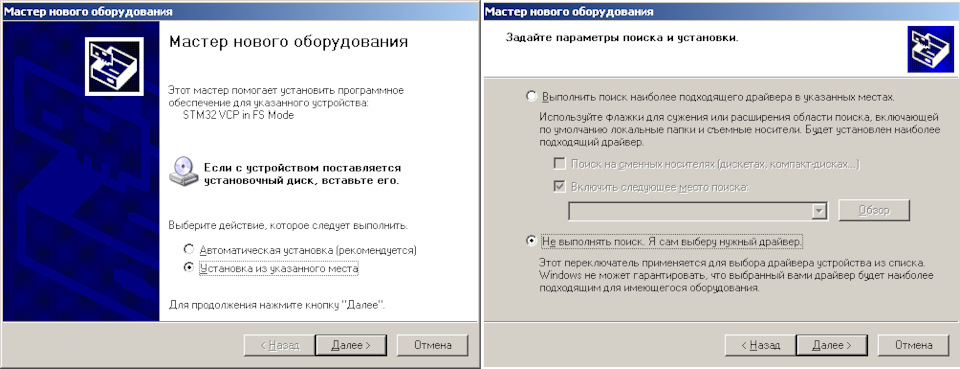
• В следующем окне в качестве «Тип устройства» выберите «Порты СОМ и LPT» и нажмите «Далее»;
• В следующем окне в качестве «Модель» выберите «STMicroelectronics Virtual COM Port» и нажмите «Далее»;
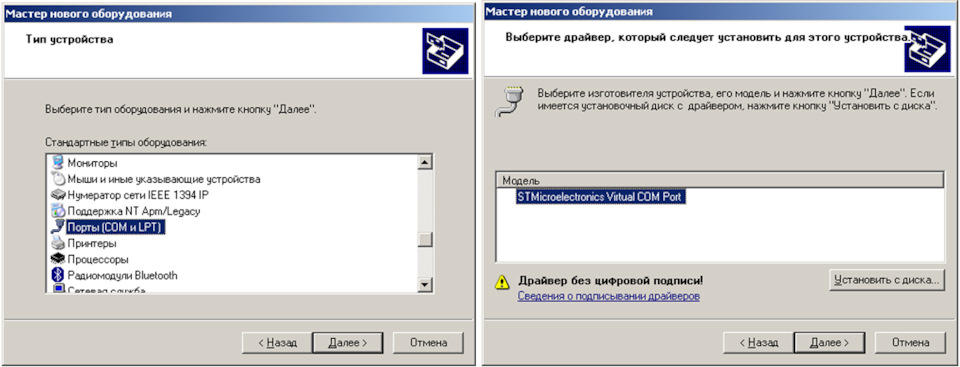
• На предупреждение системы о несовместимости драйвера нажмите кнопку «Да»;

• В процессе установки ответ на предупреждение системы об отсутствии тестирования на совместимость, нажмите кнопку «Все равно продолжить»;
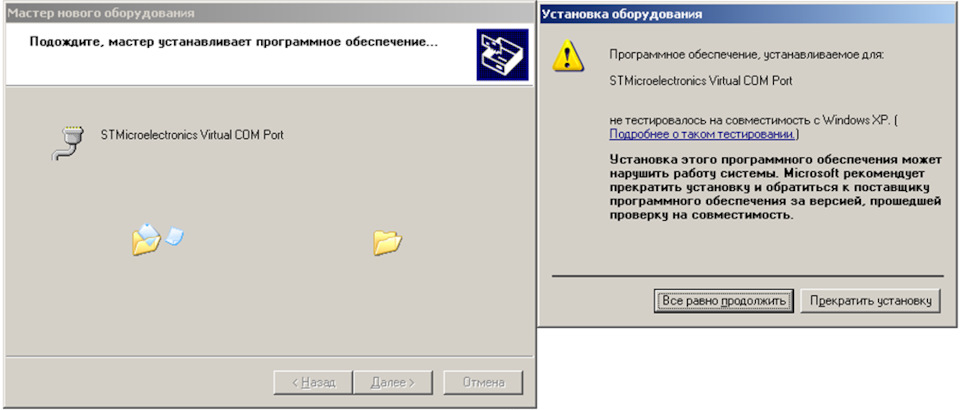
• После установки драйвера виртуального СОМ порта нажмите кнопку «Готово».
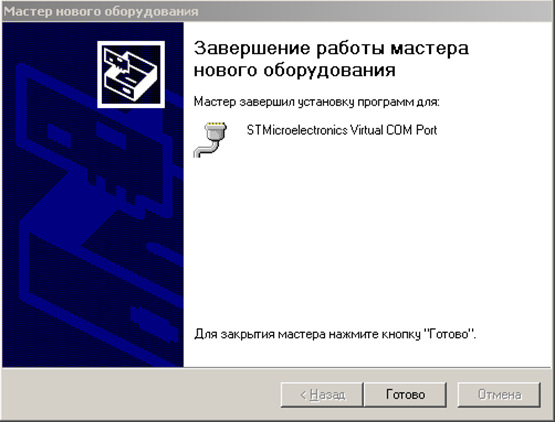
• Далее система предложит установить драйвер для составного устройства. Нужно нажать кнопку «Отмена».
• Необходимо зайти в «Диспетчер устройств» в Разделе «Контроллеры универсальной последовательной шины USB» найти последний раздел «Составное USB «устройство»» и нажать на нём правой кнопкой мыши. В появившемся меню выбрать «Обновить драйвер…»
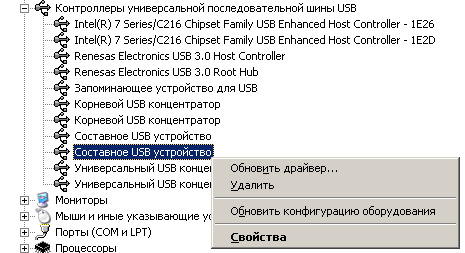
• Выполнить такие же операции, как и при установке драйвера Виртуального СОМ порты, но в окне выбора «Модель» выберите «Составное USB «устройство»»;
• После установки в диспетчере устройств его можно найти в разделе «СОМ и LPT порты».
Ссылка на драйвера версии 1.4.0
drive.google.com/file/d/1…wbwVidLm/view?usp=sharing
Ссылка на документ по установке драйверов
drive.google.com/file/d/1…6H-dyr29/view?usp=sharing
Список драйверов для контроллера портов от STMicroelectronics.
Выберите драйвер для своей операционной системы и ее разрядности. Рекомендуется устанавливать более позднюю версию драйвера (смотрите на дату выхода).
Для перехода к скачиванию файла нажмите на ссылку.
| Драйвер / Устройство | Операционная система |
Дата выхода Версия |
Ссылка на скачивание |
|
|---|---|---|---|---|
STM Virtual COM Port Drivers |
Windows XP, Windows Vista, Windows 7, Windows 8 32-bit (x86), 64-bit (x64) |
2010-04-25 1.3.1 |
Сайт не содержит материалов, защищенных авторскими правами. Все файлы взяты из открытых источников.
© 2012-2025 DriversLab | Каталог драйверов, новые драйвера для ПК, скачать бесплатно для Windows
kamtizis@mail.ru
Страница сгенерирована за 0.037390 секунд
«stmicroelectronics driver»
|
Updates: |
Previous Next
|
| Title | Products | Classification | Last Updated | Version | Size |
Download |
|
|---|---|---|---|---|---|---|---|
|
STMicroelectronics — Sensor — 1.0.6.3 |
Windows 11 Client, version 24H2 and later, Servicing Drivers, Windows 11 Client, version 24H2 and later, Upgrade & Servicing Drivers | Drivers (Other Hardware) | 9/8/2024 | n/a |
127 KB 130388 |
||
|
STMicroelectronics — Sensor — 1.0.6.3 |
Windows 10, Vibranium and later, Servicing Drivers, Windows 10, Vibranium and later, Upgrade & Servicing Drivers | Drivers (Other Hardware) | 9/8/2024 | n/a |
127 KB 130388 |
||
|
STMicroelectronics — Sensor — 3.1.7.0 |
Windows — Client, version 21H2 and later, Servicing Drivers, Windows — Client, version 21H2 and later, Upgrade & Servicing Drivers | Drivers (Other Hardware) | 8/10/2022 | n/a |
123 KB 126599 |
||
|
STMicroelectronics — Sensor — 3.1.7.0 |
Windows 10, Vibranium and later, Servicing Drivers, Windows 10, Vibranium and later, Upgrade & Servicing Drivers | Drivers (Other Hardware) | 8/10/2022 | n/a |
123 KB 126599 |
||
|
STMicroelectronics — Sensor — 3.1.7.0 |
Windows — Client, version 21H2 and later, Servicing Drivers, Windows — Client, version 21H2 and later, Upgrade & Servicing Drivers | Drivers (Other Hardware) | 8/10/2022 | n/a |
123 KB 126599 |
||
|
STMicroelectronics — Sensor — 3.1.7.0 |
Windows 10, Vibranium and later, Servicing Drivers, Windows 10, Vibranium and later, Upgrade & Servicing Drivers | Drivers (Other Hardware) | 8/10/2022 | n/a |
123 KB 126599 |
||
|
STMicroelectronics — Sensor — 3.1.7.0 |
Windows 11 Client, version 22H2 and later, Servicing Drivers, Windows 11 Client, version 22H2 and later, Upgrade & Servicing Drivers | Drivers (Other Hardware) | 8/10/2022 | n/a |
123 KB 126599 |
||
|
STMicroelectronics — Sensor — 3.1.7.0 |
Windows 11 Client, version 22H2 and later, Servicing Drivers, Windows 11 Client, version 22H2 and later, Upgrade & Servicing Drivers | Drivers (Other Hardware) | 8/10/2022 | n/a |
123 KB 126599 |
||
|
STMicroelectronics — Sensor — 1.0.2.9 |
Windows — Client, version 21H2 and later, Servicing Drivers, Windows — Client, version 21H2 and later, Upgrade & Servicing Drivers, Windows — Client S, version 21H2 and later, Servicing Drivers, Windows — Client S, version 21H2 and later, Upgrade & Servicing Drivers | Drivers (Other Hardware) | 11/22/2021 | n/a |
275 KB 281693 |
||
|
STMicroelectronics — Sensor — 1.2.2.2 |
Windows — Client, version 21H2 and later, Servicing Drivers, Windows — Client, version 21H2 and later, Upgrade & Servicing Drivers, Windows — Client S, version 21H2 and later, Servicing Drivers, Windows — Client S, version 21H2 and later, Upgrade & Servicing Drivers | Drivers (Other Hardware) | 11/15/2021 | n/a |
108 KB 111589 |
||
|
STMicroelectronics — Sensor — 1.0.2.7 |
Windows — Client, version 21H2 and later, Servicing Drivers, Windows — Client, version 21H2 and later, Upgrade & Servicing Drivers | Drivers (Other Hardware) | 9/2/2021 | n/a |
105 KB 108268 |
||
|
STMicroelectronics — Sensor — 1.0.2.7 |
Windows — Client, version 21H2 and later, Servicing Drivers, Windows — Client, version 21H2 and later, Upgrade & Servicing Drivers | Drivers (Other Hardware) | 9/2/2021 | n/a |
105 KB 108268 |
||
|
STMicroelectronics — Sensor — 3.1.5.0 |
Windows — Client, version 21H2 and later, Servicing Drivers, Windows — Client, version 21H2 and later, Upgrade & Servicing Drivers | Drivers (Other Hardware) | 8/9/2021 | n/a |
104 KB 107511 |
||
|
STMicroelectronics — Sensor — 3.1.5.0 |
Windows — Client, version 21H2 and later, Servicing Drivers, Windows — Client, version 21H2 and later, Upgrade & Servicing Drivers | Drivers (Other Hardware) | 8/9/2021 | n/a |
104 KB 107511 |
||
|
STMicroelectronics — System — 2.2.7.5 |
Windows — Client, version 21H2 and later, Servicing Drivers, Windows — Client, version 21H2 and later, Upgrade & Servicing Drivers | Drivers (Other Hardware) | 8/1/2021 | n/a |
108 KB 110680 |
||
|
STMicroelectronics — System — 2.2.7.5 |
Windows 10, Vibranium and later, Servicing Drivers, Windows 10, Vibranium and later, Upgrade & Servicing Drivers | Drivers (Other Hardware) | 8/1/2021 | n/a |
108 KB 110680 |
||
|
STMicroelectronics — Sensor — 3.1.4.0 |
Windows 10, Vibranium and later, Servicing Drivers, Windows 10, Vibranium and later, Upgrade & Servicing Drivers | Drivers (Other Hardware) | 5/3/2021 | n/a |
105 KB 107923 |
||
|
STMicroelectronics — Sensor — 3.1.4.0 |
Windows 10, Vibranium and later, Servicing Drivers, Windows 10, Vibranium and later, Upgrade & Servicing Drivers | Drivers (Other Hardware) | 5/3/2021 | n/a |
105 KB 107923 |
||
|
STMicroelectronics — Sensor — 1.0.2.6 |
Windows 10, Vibranium and later, Servicing Drivers, Windows 10, Vibranium and later, Upgrade & Servicing Drivers | Drivers (Other Hardware) | 4/18/2021 | n/a |
260 KB 266925 |
||
|
STMicroelectronics — System — 2.2.7.4 |
Windows 10, Vibranium and later, Servicing Drivers, Windows 10, Vibranium and later, Upgrade & Servicing Drivers | Drivers (Other Hardware) | 4/12/2021 | n/a |
83 KB 85996 |
||
|
STMicroelectronics — System — 2.2.7.4 |
Windows 10, Vibranium and later, Servicing Drivers, Windows 10, Vibranium and later, Upgrade & Servicing Drivers | Drivers (Other Hardware) | 4/12/2021 | n/a |
94 KB 96754 |
||
|
STMicroelectronics — System — 2.2.7.4 |
Windows 10, Vibranium and later, Servicing Drivers, Windows 10, Vibranium and later, Upgrade & Servicing Drivers | Drivers (Other Hardware) | 4/12/2021 | n/a |
94 KB 96754 |
||
|
STMicroelectronics — System — 2.2.7.4 |
Windows 10, Vibranium and later, Servicing Drivers, Windows 10, Vibranium and later, Upgrade & Servicing Drivers | Drivers (Other Hardware) | 4/12/2021 | n/a |
83 KB 85996 |
||
|
STMicroelectronics — Sensor — 1.0.2.5 |
Windows 10, version 1903 and later, Servicing Drivers, Windows 10, version 1903 and later, Upgrade & Servicing Drivers, Windows 10 S, version 1903 and later, Servicing Drivers, Windows 10 S, version 1903 and later, Upgrade & Servicing Drivers | Drivers (Other Hardware) | 3/28/2021 | n/a |
107 KB 109992 |
||
|
STMicroelectronics — Sensor — 1.0.2.5 |
Windows — Client, version 21H2 and later, Servicing Drivers, Windows — Client, version 21H2 and later, Upgrade & Servicing Drivers, Windows — Client S, version 21H2 and later, Servicing Drivers, Windows — Client S, version 21H2 and later, Upgrade & Servicing Drivers | Drivers (Other Hardware) | 3/28/2021 | n/a |
107 KB 109992 |
Add
Add All
Remove
Remove All
На чтение4 мин
Опубликовано
Обновлено
Пакет драйверов Windows для STMicroelectronics является программным обеспечением, предназначенным для управления и взаимодействия с устройствами, разработанными компанией STMicroelectronics. Драйверы играют важную роль в операционных системах Windows, обеспечивая стабильную работу аппаратных компонентов, таких как микросхемы, сенсоры и другие устройства, произведенные STMicroelectronics.
STMicroelectronics является одной из ведущих компаний в области полупроводников и микроэлектроники. Она предлагает широкий спектр продуктов, включая микроконтроллеры, датчики, драйверы мощности и другие компоненты, которые необходимы для работы различных устройств и систем.
Пакет драйверов Windows для STMicroelectronics обеспечивает возможность подключения, управления и обмена данными с устройствами STMicroelectronics, используя операционную систему Windows. Он содержит необходимые драйверы, программные интерфейсы и утилиты для обеспечения совместимости и корректной работы устройств STMicroelectronics с ОС Windows.
Функциональность пакета драйверов включает в себя поддержку различных интерфейсов связи, таких как USB, UART, I2C и SPI, а также возможность настройки и калибровки устройств, анализа состояния и диагностики проблем, связанных с использованием этих устройств. Пакет драйверов облегчает разработку программного обеспечения для работы с устройствами STMicroelectronics в операционной системе Windows.
Что такое пакет драйверов Windows для STMicroelectronics
Пакет драйверов Windows для STMicroelectronics представляет собой набор программных компонентов, предназначенных для обеспечения взаимодействия операционной системы Windows и устройств, разработанных и производимых компанией STMicroelectronics.
Драйверы Windows для STMicroelectronics выполняют важную роль, обеспечивая связь между операционной системой и устройствами. Они позволяют операционной системе распознавать и использовать возможности устройства, такие как передача данных, управление и конфигурация.
Пакет драйверов Windows для STMicroelectronics включает драйверы для различных типов устройств, включая микроконтроллеры, сенсоры, датчики, встраиваемые системы и другие. Каждый драйвер предназначен для конкретного типа устройства и обеспечивает его оптимальную работу в операционной системе Windows.
Основная функциональность пакета драйверов Windows для STMicroelectronics включает:
| Функции | Описание |
|---|---|
| Распознавание устройств | Драйверы позволяют операционной системе распознавать подключаемые устройства и автоматически устанавливать соответствующие драйверы. |
| Управление устройствами | Драйверы предоставляют интерфейсы и функции для управления функциями устройства, такими как включение/выключение, настройка параметров и проверка состояния. |
| Передача данных | Драйверы обеспечивают передачу данных между устройством и программными приложениями, позволяя осуществлять чтение, запись и обработку данных. |
| Обработка событий | Драйверы могут обрабатывать различные события, происходящие в устройстве, и передавать эти события в операционную систему или другие приложения. |
Наличие правильно установленного и обновленного пакета драйверов Windows для STMicroelectronics важно для стабильной и оптимальной работы устройств в операционной системе Windows. Пользователям рекомендуется периодически проверять наличие новых версий драйверов на официальном веб-сайте компании STMicroelectronics и устанавливать их для обеспечения совместимости и исправления возможных проблем.
Основные сведения
Драйверы Windows для STMicroelectronics включают в себя несколько компонентов, включая INF-файлы, SYS-файлы и DLL-файлы. INF-файлы содержат информацию о поддерживаемых устройствах и их свойствах, а также инструкции для установки драйвера. SYS-файлы являются основной частью драйвера и содержат код, необходимый для взаимодействия с устройством. DLL-файлы предоставляют дополнительные функции, используемые драйвером.
Одной из основных функций драйверов является обеспечение поддержки устройств STMicroelectronics в операционной системе Windows. Это включает в себя распознавание устройства системой, предоставление доступа к его функциям и возможность управления устройством через операционную систему. Драйверы также обеспечивают передачу данных между устройством и операционной системой, а также обработку ошибок и исключительных ситуаций.
Пакет драйверов Windows для STMicroelectronics поддерживает широкий спектр устройств, включая микросхемы памяти, микроконтроллеры, сенсоры и другие полупроводниковые устройства. Кроме того, драйверы обеспечивают совместимость с различными версиями Windows, включая Windows 10, Windows 8 и Windows 7.
Использование пакета драйверов Windows для STMicroelectronics обеспечивает простоту установки и обновления драйверов, улучшает работу устройств STMicroelectronics в операционной системе Windows и обеспечивает максимальную совместимость и надежность работы устройств.
Важно: При установке и использовании пакета драйверов Windows для STMicroelectronics рекомендуется следовать инструкциям и рекомендациям производителя, чтобы избежать проблем и обеспечить правильное функционирование устройств.
Зачем нужен пакет драйверов
Пакет драйверов выполняет ряд важных функций:
1. Управление устройством. Драйверы позволяют операционной системе контролировать и управлять работой устройства. Они обеспечивают доступ к различным возможностям и функциям, предоставляемым устройством, и позволяют операционной системе взаимодействовать с устройством через стандартизированный интерфейс.
2. Обеспечение совместимости. Драйверы предоставляют интерфейс, который позволяет операционной системе и прикладным программам использовать устройства STMicroelectronics. Они обеспечивают поддержку специфических протоколов и возможностей, которые могут быть уникальными для устройств STMicroelectronics.
3. Обеспечение стабильности и безопасности. Драйверы разработаны, чтобы обеспечить надежное и безопасное функционирование устройств STMicroelectronics в среде операционной системы Windows. Они проходят тщательное тестирование и сертификацию, чтобы минимизировать возможные проблемы и конфликты с другими компонентами системы.
4. Обновление и поддержка. Пакет драйверов обеспечивает возможность обновления драйверов для устройств STMicroelectronics и получения новых версий с исправлениями ошибок и новыми функциями. Это позволяет поддерживать устройства в актуальном состоянии и получать максимальную производительность и совместимость с операционной системой Windows.
В целом, пакет драйверов Windows для STMicroelectronics играет важную роль в обеспечении правильной работы устройств STMicroelectronics в среде операционной системы Windows. Он обеспечивает стабильность, совместимость и функциональность, которая необходима для использования этих устройств в различных приложениях и сценариях.
1 — Introduction
This repository contains examples of low-level platform-independent drivers for STMicroelectronics sensors. Sensor drivers and examples are written in C programming language.
If you are using STM32Cube packages, evaluate also the hardware abstractions STM32Cube-compatible drivers.
The STMicroelectronics naming convention for driver repositories is:
PARTNUMBER(e.g. hts221) for low-level platform-independent driversstm32-PARTNUMBER(e.g. stm32-hts221) for hardware-abstracted STM32Cube-compatible drivers
1.a — Repository structure
This repository contains two types of folders, identifiable using the following naming convention:
- folder that contains the sensor drivers, named
xxxxxxx_STdCwherexxxxxxxidentifies the sensor part number - folder that contains the demo project, named
_prj_XXXXXXXwhereXXXXXXXis the name of the ST evaluation board
Another folder, named _resources, cannot be identified with the two types described above and contains other useful resources such as libraries and predefined device configurations used in some examples. In order to clone the complete content of this folder, use the command:
git clone --recursive https://github.com/STMicroelectronics/STMems_Standard_C_drivers
1.b — Sensor driver folder structure
Every sensor driver folder contains:
xxxxxxx_STdC\driver: this folder points to another repository which contains only the sensor driver files (.h and .c) to be included, or linked directly as a git submodule, in your project. Driver documentation can be generated using the Doxygen tool.xxxxxxx_STdC\examples: examples showing how to integrate the C driver in a project. They are written for STM32 Microcontrollers using the STM32CubeMX tool, but they can be used as a guideline for every platform.- README: additional info about the specific driver.
1.c — Demo project folder structure
Every demo project folder contains a single configuration file for the STM32CubeMX tool named _prj_XXXXXXX\XXXXXX.ioc where XXXXXXX is the name of the ST evaluation board.
Using the STM32CubeMX tool (configured with the related MCU package) and the .ioc file, it is possible to create a project in which you can easily run the examples available in each sensor driver folder.
2 — Integration details
The driver is platform-independent, you only need to define the two functions for read and write transactions from the sensor hardware bus (ie. SPI or I2C/I3C) and a platform dependent delay function, which is sometimes required by the underlying driver.
Note: A few devices integrate an extra bit in the communication protocol in order to enable multi read/write access, this bit must be managed in read and write functions defined by the user. Please refer to the read and write implementation in the reference examples.
2.a Source code integration
-
Include in your project the driver files of the sensor (.h and .c) located in the
xxxxxxx_STdC\driverfolder of the corresponding product. -
Define in your code the read and write as well as the delay functions that use the I2C, I3C or SPI platform driver like the following:
/** Please note that it is MANDATORY: return 0 -> no Error.**/ int32_t platform_write(void *handle, uint8_t Reg, const uint8_t *Bufp, uint16_t len); int32_t platform_read(void *handle, uint8_t Reg, uint8_t *Bufp, uint16_t len); void platform_delay(uint32_t ms);
- Declare and initialize the structure of the device interface:
xxxxxxx_ctx_t dev_ctx; /** xxxxxxx is the used part number **/ dev_ctx.write_reg = platform_write; dev_ctx.read_reg = platform_read; dev_ctx.mdelay = platform_delay;
- If needed by the platform read and write functions, initialize the handle parameter:
dev_ctx.handle = &platform_handle;
- Any additional initialization work has to be done in platform_init routine:
void platform_init(void);
2.b Required properties
- A standard C language compiler for the target MCU
- A C library for the target MCU and the desired interface (i.e. SPI, I2C, I3C)
3 — Running examples
Examples are written for STM32 Microcontrollers using the STM32CubeMX tool, but they can be used as a guideline for every platform.
3.a Using STMicroelectronics evaluation boards
When using the supported STMicroelectronics evaluation boards, the example file(.c) can be run without applying any modifications (as is).
In order to run that file, please follow these steps:
- Download and install the STM32CubeMX tool and the related MCU package (i.e. STM32F4 for NucleoF401 and STEVAL_MKI109V3 and STM32H5 for NucleoH503).
- Open the
.iocconfiguration file associated to the selected evaluation board with the STM32CubeMX tool. The.iocconfiguration files for the supported evaluation boards can be found in the related ST evaluation board demo project folder. - Generate the project using the STM32CubeMX tool and select your preferred IDE / toolchain.
- Add to your project the STMicroelectronics sensor driver. Driver files are located in the sensor drivers folder at
xxxxxxx_STdC\driver\xxxxxxx_reg.c(.h)wherexxxxxxxidentifies the sensor part number. - Add to your project the example source file (.c) that you are interested in. Example files are located in the sensor drivers folder at
xxxxxxx_STdC\examplewherexxxxxxxidentifies the sensor part number. - Uncomment the selected board definition in section
/* STMicroelectronics evaluation boards definition */in the selected example file (.c). - Add the call to the example function inside the
while(1)loop in themain()function of themain.cfile automatically generated by the STM32CubeMX tool. - Open a terminal emulator to see messages and configure it as 115200 8n1 for NucleoF401 and STEVAL_MKI109V3 or 921600 8n1 for NucleoH503.
- Enjoy
More info is available in each specific provided example platform:
- NUCLEO_F401RE
- STEVAL_MKI109V3
- NUCLEO_H503RB
If you are using STM32Cube packages, evaluate also the hardware-abstracted STM32Cube-compatible drivers specifically designed to be compatible with the STM32Cube. The complete list is provided here.
3.b Running examples using different hardware
If a different MCU is used, please follow these steps:
-
Add the STMicroelectronics sensor driver to your project. Driver files are located in the sensor drivers folder at
xxxxxxx_STdC\driver\xxxxxxx_reg.c(.h)wherexxxxxxxidentifies a sensor part number. -
Add the example source file (.c) that interests you to your project. Example files are located in the sensor drivers folder at
xxxxxxx_STdC\examplewherexxxxxxxidentifies the sensor part number. -
Comment all the definitions of the boards in section `/* STMicroelectronics evaluation boards definition */ in the selected example file(.c).
-
Add the call to the example function inside the
while(1)loop in yourmain()function. -
Modify in the selected example file (.c) the hardware-related functions:
platform_write(void *handle, uint8_t Reg, const uint8_t *Bufp,uint16_t len)platform_read(void *handle, uint8_t Reg, uint8_t *Bufp, uint16_t len)void platform_delay(uint32_t ms)- if needed, add/replace the hardware-related functions reported in the example file.
-
Enjoy
More information: http://www.st.com
Copyright (C) 2018-2024 STMicroelectronics

